Sphinginae subfamily
Sphingini tribe:
 |
Pink-spotted hawkmoth -- (Agrius cingulata) WO
stray
This moth is a very strong flier, but would only make its way to
Schuyler as a rare stray. There are not too many records from
New York state, but records exist for NJ and CT.
|
 |
Ceratomia amyntor
WO,
the Elm Sphinx or Four-horned Sphinx
The upperside of the forewing is brown with dark brown and white
markings including a white costal area near the wing base, dark
streaks along the veins, and a white spot in the cell.
|
 |
The upperside of the forewing is pale brownish gray with wavy black
and white lines and a black-outlined white cell spot.
|
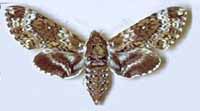 |
The upperside of the forewing is dark brown with a dusting of white
scales. Some moths have patches of reddish or yellowish brown on the
wings.
|
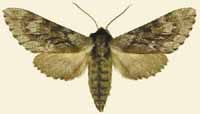 |
The upperside of the forewing is gray with heavy black bands. The
upperside of the hindwing is brownish gray with no markings.
|
 |
Manduca quinquemaculata
WO,
the Five-spotted Hawkmoth
The moth abdomen usually has five but sometimes six pairs of yellow
bands. The upperside of the forewing is blurry brown and gray.
I suspect if you grow tomatoes, you are likely to encounter it.
|
 |
The abdomen usually has six pairs of yellow bands, broken across the
back. The sixth set of markings is quite small.
The upperside of the forewing has indistinct black, brown, and
white markings.
Larvae get very large and can strip a tomato plant.
|
 | The upperside of the forewing is gray with indistinct black and white markings.
There is a series of black dashes
from the base to the tip, and a small white cell spot. More likely further south!
|
 |
Sphinx chersis WO, the Northern Ash Sphinx or Great Ash Sphinx
This species is present but may not
be common. Larval hosts are ash, lilac, privet, cherry, and quaking aspen.
|
 |
Forewings, long and slender, are held close to the body when the
moth is at rest. Mature larvae are beautifulk.
|
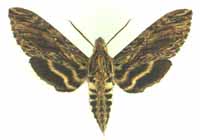 |
This species is reported in nearby Tompkins. Generally it is not
widely reported. |
 |
The lower forewings are predominantly brownish-yellow with a fairly
wide dark bar along the inner margin. At rest the wings hug the body,
giving the moth a long slender look.
|
 |
Sphinx luscitiosa WO,
the Canadian Sphinx or
Clemen's Sphinx
This one is reported from Suffolk and Richmond and from
northeastern New Jersey. Unlikely!
|
 |
If you have blueberries in the woods, then you should have the Poecila Sphinx.
They are pretty common here on Prince Edward Island, but don't fly
too far south of Massachusetts, being replaced by Sphinx gordius
in Connecticut. Confirmed! |
Smerinthini Tribe:
 |
The adults are also highly variable; sometimes wings of an individual may be all one color or may have several colors, ranging from pale to dark brown,
and may have a white or pink tinge.
|
 |
Pachysphinx modesta
WO,
the Modest Sphinx or Poplar Sphinx
This moth is recorded in nearby Tompkins County. It is fond of
poplars and willows.
They are common on Prince Edward Island. |
 |
Named for the dull grey-blue spot (minus dark pupil) in the hindwing,
this moth has a wide distribution and is probably common in Schuyler
County.
I regularly see them on Prince Edward Island, and they are reported
as far south as Florida. |
 |
Named for the small eye-spot in the hindwing, this moth has a wide
distribution and is probably common in Schuyler County.
I regularly see them on Prince Edward Island, and they are reported as far south as Florida.
|
 |
Schuyler would be close to the southern limit for this species in
New York.
I never saw one in New Jersey. At my home in Montague, P.E.I.,
Canada, they are quite common. |
 |
This moth is widely distributed and fairly common.
Along the East Coast, it flies from P.E.I. to Florida. |
Macroglossinae subfamily
Dilophonotini tribe:
See Hemaris comparison to help distinguish
the next three species.
 |
Hemaris thysbe BD, the Hummingbird Clearwing
This interesting day flier is reported in Schuyler by Bob Dirig, and
is widely reported to the north, east, south and west.
They are widely distributed in the east from P.E.I. to Florida.
|
Hemaris thysbe, July 23, 2006, Rock Cabin Road near
Montour Falls, Bob Dirig.
 |
Hemaris diffinis
BD/USGS, the
Snowberry Clearwing or Bumblebee Moth
This moth is widespread and has been recorded in Schuyler and
in northwestern N.J. and southeastern N.Y. and Connecticut.
|
Hemaris diffinis, July 23, 2006, Rock Cabin Road near
Montour Falls, Bob Dirig.
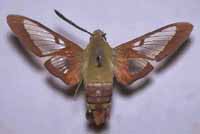 |
Hemaris gracilis
WO, the
Slender Clearwing or Graceful Clearwing
This day-flying moth is less common and has not been recorded in
Schuyler, but has been seen due east, south and west. Questionable.
|
Philampelini tribe:
 |
This moth is reported for nearby Tompkins, and it is fairly often reported
along the coast from southern New Jersey
to central Maine.
Note the differences between this moth and the Pandorus Sphinx. |
 |
If you have Grape or Virginia Creeper nearby, then you probably have
this species.
I often get asked to identify larvae from areas not
previously reported. |
Macroglossini tribe:
 |
This day flier is widely distributed. If you have Virginia Creeper,
you probably have the Nessus Sphinx. Two bright, distinct, narrow yellow
bands are often visible on the abdomen.
|
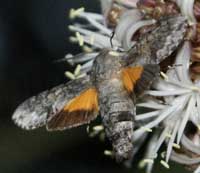 |
This species is rarely recorded in the U.S., but there are sightings
in the east from Florida, South Carolina, New Jersey, New York,
Massachusetts and New Hampshire.
There are no reports from
Schuyler. Very Questionable!
|
 |
They are common in New Jersey and common
here on Prince Edward Island.
You will often see this species listed as Darapsa pholus,
especially in older literature.
It is probably present in
Schuyler.
|
 |
Darapsa myron WO, the Virginia Creeper Sphinx or the Grapevine Sphinx
This moth is recorded on the U.S.G.S. site for nearby Tompkins County.
It is widely reported as far north as southern Maine. If you have the
foodplants indicated in the common names, you probably have this
species nearby. |
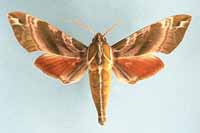 |
If you have hydrangea growing near a stream, then you may have the
Hydrangea Sphinx.
It has been reported in nearby Tompkins, but likely is uncommon.
|
 |
This species has been recorded in Schuyler and in surrounding areas. |
 |
Hyles gallii WO, the Bedstraw Hawk Moth
or Gallium Sphinx
This species is reported in nearby Tompkins. I suspect it would be rare.
Some years I see them on P.E.I., some years, I do not.
|
 |
Hyles lineata WO, the White-lined Sphinx
This species is not reported from Schuyler County. It flies across
southern New York and has strong migrating tendancies.
There are records from New Hampshire and Maine. |
 |
This moth is very much under reported across the United States. It
is a rapid day flier so is probably not in too many collections.
Grape is a popular larval host.
|
|
|
